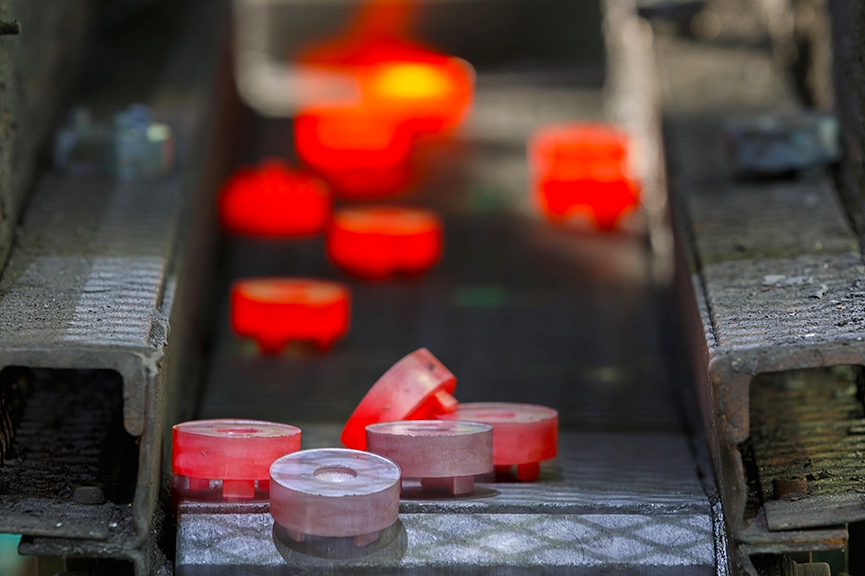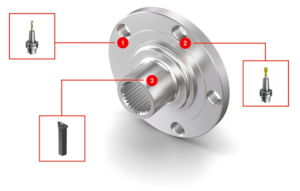Email: info@nbtias.com

Heat treatment is a thermal process that accomplishes three primary improvements to the material properties of metal castings:
- Improving mechanical properties
- Enhancing corrosion resistance
- Reducing residual stresses
The heat treatment process begins with heating the metal casting to the desired temperature before cooling the metal in a controlled way to achieve the desired improvements. This heating and cooling process “locks in” the final metal microstructure and the improved material properties.

Why Heat Treatment?
As outlined above heat treatment is used to achieve a variety of desired outcomes for a metal casting. Heat treatment can also be designed to reduce hydrogen levels, simulate in-service conditions, restore mechanical properties, and reduce stresses after a project is welded. These various outcomes are achieved with different heat treatment processes. The overarching objective of heat treatment is to achieve customer specification requirements and comply with industry standards. MetalTek’s certifications for heat treatment include NADCAP and compliance with AMS 2750. NADCAP is an accreditation program to establish uniform manufacturing processes for aerospace engineering, defense, and related industries.
What Types Of Heat Treatment Are There?
While there are a range of different heat treatment processes available , some are used more often than others.
Homogenizing Heat Treatment:
This process involves heating the metal casting in a furnace to an extremely hot temperature and holding for an extended period to improve chemical uniformity by diffusion. Homogenization is sometimes employed as a pre-treatment to make subsequent heat treatments more effective.
Normalizing Heat Treatment:
Normalizing is heating the metal casting to an elevated temperature above the transformation temperature and then air cooling it back to room temperature. This process alters the microstructure to reduce the variation in hardness and ductility within the casting. The temperatures and times are typically lower and shorter than for homogenization. Normalizing is often followed by tempering. Tempering is heating the metal casting to a temperature below the transformation temperature to lower the hardness and improve the ductility of the metal.
Hardening Heat Treatment And Quenching Heat Treatment:
The use of this treatment results in an improvement in metal casting mechanical properties, related especially to increasing hardness or durability. It is often used for steel parts. Metal is heated to an elevated temperature (above the transformation temperature) and then rapidly cooled (quenched). This causes the softer initial material to transform its structure into a stronger one.
Quenching cools the metal casting after the initial heating process. The quench is typically performed in oil or water, depending on the material and specification requirements. Tempering is the last step in the hardening and tempering process and is required after the quench. It involves reheating the metal at a low temperature (below the transformation temperature) to achieve final specifications. Tempering lowers the as-quenched hardness, restores ductility, and reduces stresses of fully hardened steel. MetalTek frequently uses this full process.
Anneal Heat Treatment:
Annealing is heating and holding the metal at an elevated temperature followed by furnace cooling to obtain the desired hardness. This is typically performed on “hardenable” ferrous alloys to reduce hardness, increase ductility, and improve the machinability of the casting. This process is often used on tool steels, alloy steels, and martensitic stainless steels to allow for quick rough machining prior to any hardening and tempering operation.
Solution Anneal Heat Treatment:
Solution annealing is heating and holding metal at an elevated temperature to cause constituents like carbides and undesirable phases to go into solid solution and then cooled rapidly to hold these constituents in solution. This process improves mechanical properties and the corrosion resistance of an alloy. Austenitic and duplex stainless steels are typically supplied in the solution annealed condition.
Stress Relieving Heat Treatment:
Stress relieving is heating to a relatively low temperature and holding for a long enough time to reduce residual stress within the casting. The process typically employs controlled heating and cooling rates to minimize the development of new stresses. Stress relieving is often done after rough machining prior to tight-tolerance finish machining work.
Other Heat Treatments:
Other heat treatment processes performed include post-weld heat treatments, stabilization, hydrogen bake, and simulated “in-service” heat treatments. At the end of the day, the specific heat treatment process used is determined by what the customer needs. Customers sometimes want parts “softer” so they can be more easily machined. Other metal castings must be made stronger and more durable. The final microstructure desired also informs the choice of the heat treatment process used.



